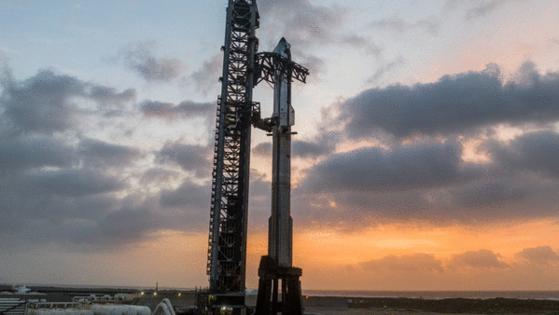While Florida Starship launches wait, SpaceX lines up latest Texas test flight
Published in News & Features
SpaceX is set to launch its 11th test flight of the powerful Starship and Super Heavy rocket from its Texas site Starbase on Monday as it moves ahead in its goals to achieve an operational rocket that could eventually launch from Florida.
The launch window opens at 7:15 p.m. Eastern time looking for a repeat of the successful 10th test flight in August, and avoid the calamities of its explosive test flights earlier in the year.
For the second time, SpaceX will be using a Super Heavy booster that had previously been flown, having been one of three times the company successfully captured the booster back at the launch site using the launch tower’s “chopsticks.” This booster flew on Flight 8 in March The first-ever Super Heavy booster catch came a year ago in October 2024.
For this flight, though, there won’t be another try to capture back at the tower, with the booster instead aiming for a controlled descent, but ultimate water landing in the Gulf. The company is reusing 24 of the 33 Raptor engines on the booster, and will adjust its landing burn to that mimic the burn planned for the next generation of Super Heavy booster.
The upper Starship stage will be doing the same flight plan as previous attempts, aiming for a suborbital trip more than halfway around the Earth with a controlled water landing in the Indian Ocean off the west coast of Australia.
Once again, SpaceX will try to deploy some payloads that simulate the size of future Starlink satellites. The simulators will follow the upper stage’s trajectory and burn up on reentry or fall into the Indian Ocean. The company will also attempt again a relight of one of the six Raptor engines midflight.
“The flight test includes several experiments and operational changes focused on enabling Starship’s upper stage to return to the launch site on future flights,” the company posted on its website. “For reentry, tiles have been removed from Starship to intentionally stress-test vulnerable areas across the vehicle.”
Starship is the most powerful rocket to ever make it to space with nearly 17 million pounds of thrust at liftoff, which is nearly double the power of NASA’s Space Launch System rocket used on Artemis missions.
Future test flights aim to bring the Starship upper stage back to Texas for a controlled landing that would recover the vehicle, part of the company’s plans for a fully reusable rocket.
The company is in the midst of building out launch sites at both Kennedy Space Center and Cape Canaveral Space Force Station that could handle as many as 120 launches a year, if approved by the Federal Aviation Administration. Construction of a Starship manufacturing site at KSC called the “Gigabay,” is underway, part of a $1.8 billion infrastructure project to support Space Coast launches.
Environmental reports about those plans, though, have raised local concerns about airspace closures that could affect more than 12,000 flights a year, including those at Orlando International Airport. Other concerns have included overnight sonic booms and the closure of the popular beaches on Canaveral National Seashore.
SpaceX, on the defensive about actual airspace closure effects, issued a statement about how short a time the FAA had to keep airspace closed on the last launch out of Texas.
“SpaceX works closely with FAA and international air traffic organizations to efficiently and safely integrate all launch and reentry operations into the airspace,” the company stated.
On Starship Flight 10, SpaceX noted all affected airspace was reopened within nine minutes, including some portions within seven minutes, equating to “no meaningful disruption to air traffic.”
_____
©2025 Orlando Sentinel. Visit orlandosentinel.com. Distributed by Tribune Content Agency, LLC.







Comments